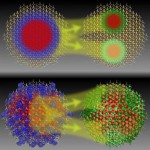 According to the theory of multiple exciton generation, when an electron absorbs light energy can transfer energy to more than another one electron resulting in more electricity from the same amount of absorbed light. The electron full of light energy is called exciton.
According to the theory of multiple exciton generation, when an electron absorbs light energy can transfer energy to more than another one electron resulting in more electricity from the same amount of absorbed light. The electron full of light energy is called exciton.
The efficiency of solar cells could be improved due to studies done by Mark Lusk from Colorado School of Mines. Lusk and his colleagues describes how is possible that quantum dots affects the ability of particles to transfer energy to electrons. These quantum dots are made by researchers and have a behaviour that results in unusual electronic properties on a nanoscale, when light interact with matter. Each dot has a slice of the solar spectrum and that smaller one carry out multiple excitation generation for their slice more efficiently than those larger one. It is obviously that solar cells made of quantum dots tuned to the solar spectrum would be much more efficient than solar cells made by ordinary materials.
Lusk says: “We can now design nanostructured materials that generate more than one exciton from a single photon of light, putting to good use a large portion of the energy that would otherwise just heat up a solar cell.”
Renewable energy technologies will be improved by focusing on materials and innovations. The research team involved in their research the National Renewable Energy Laboratory as part of NSF which funds Renewable Energy Materials Research Science and Engineering Center at the Colorado School of Mines from Golden.
They have a particular interest to enhance the solar cells performance using the unique properties of nanostructured materials. As the NSF program director for the Division of Materials Research says in an interview: “These results are exciting because they go far toward resolving a long-standing debate within the field” and also “equally important, they will contribute to establishment of new design techniques that can be used to make more efficient solar cells.”



